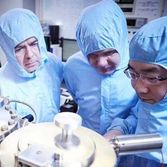Welcome to 'Atoms to Devices'
The 'Atoms to Devices' (A2D) theme runs across the Universities of Cambridge, Leeds, Manchester and Imperial College London. The vision is to provide the underpinning, cross-disciplinary, technology platforms to facilitate and support the accelerated discovery and development of new device materials. Through the deposition of precisely controlled thin films, the engineering of interfaces, and the ability to control doping on the nanoscale, A2D enables the development of new devices and technological solutions that have diverse applications in society.
Introduction and scope
Atoms to Devices is the quantum scale engineering of new technologies that can translate into applications ranging from photonics, imaging, semiconductors and sensors, to energy storage, biomedical materials and quantum technologies.
The research area comprises modelling, design, growth, fabrication, characterisation, and testing of electronic, spintronic and optoelectronic devices.
The common thread of the Atoms to Devices theme is the deposition of thin films, their fabrication into devices, their characterisation both chemically and structurally (XRD, Raman, XPS, EPMA) and their electrical testing, exploring the response of films exposed to electromagnetic fields from DC, through microwave and terahertz, to optical frequencies.
Current and future research
- Development of electronic materials for the energy transition to meet net zero carbon targets by 2050, including research into photovoltaics, calorics and thermoelectrics, and low-loss electronics.
- Demonstration of efficient catalysts to support carbon-free hydrogen generation.
- Development of new device paradigms, including ‘chargeless’ electronics, new computing architectures, and quantum technologies.
- Design of bioelectronic sensors to support personalised healthcare and clinical assessment.
- Development of resource-abundant, scalable and recyclable materials.

.jpg)


